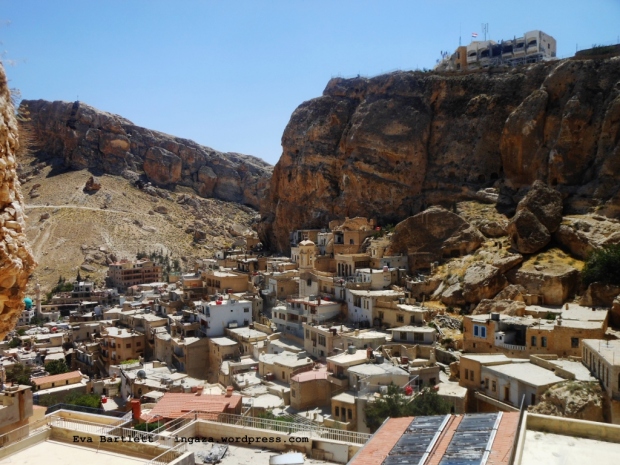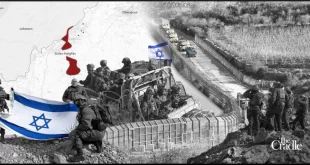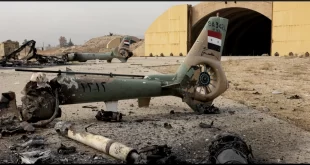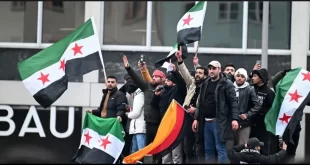
Mar 5, 2015, In Gaza
As Syrian and allied Resistance forces fight NATO’s death squads in the outskirts of Damascus, Aleppo and elsewhere in Syria, I re-visit the story of the formerly-terrorized ancient village of Ma’loula, which I visited in June 2014, two months after it had been liberated. Although no longer beset by terrorism, the story of Ma’loula is very much a current story, a case study of the senseless destruction, looting, and killing by Western-approved terrorists throughout Syria.
When I visited in June 2014, a calm prevailed. One seemingly random observation that stood out was the sound of peeping birds, which just months earlier would have been lost in the tumult of terrorist bombings and gunfire. There was the expected destruction from battles waged by and on the terrorists. There was further—clearly-intentional—destruction meted out systematically by the al-Qaeda death squads—particularly on Christian, cultural, and heritage sites.
In Ma’loula, terrorists likewise took great apparent pleasure in destroying and desecrating Christian relics, to the extent of gauging out the eyes from icons and mosaics and shooting down the large clifftop Jesus and Mary statues which had overlooked the village. They likewise burned, robbed and vandalized churches and homes.
Russia Today correspondent Maria Finoshina has reported numerous times from Ma’loula, visiting the village prior to its devastation, during its occupation, and post-liberation. Video footage from a pre-destruction visit shows children singing in Aramaic inside the then-intact and lovely church in St. Thekla convent.
In April 2014, during an Easter celebration at a Bab Touma (Thomas Gate) district restaurant in Damascus’ Old City, I met a stunning young woman, Diala. During a pause in the pro-Syria and pro-President al-Assad songs blasting all evening, she’d stood up and beautifully sung in a cappella. As it happened, she was from Ma’loula; many of Ma’loula’s displaced residents have temporarily re-settled in the Bab Touma district.
We spoke briefly, curtailed by the raging party. Her words echoed reports on Ma’loula. “We were living happily, no one bothered us, but when the terrorists came, they destroyed, slaughtered, kidnapped, and stole. They destroyed the holy churches, stole icons…”
The terrorists weren’t welcomed by Ma’loula residents, she said, but that their numbers were so great they were able to take hold of certain areas. Just how many of Ma’loula’s residents were slaughtered is not yet known, but villagers were murdered by the West’s thugs.
In a September 2013 interview with Ma’loula refugees, Maria Finoshina wrote: “Antoinette Taaleb, a Ma’loula resident, had three members of her family killed by jihadists on the first day of the village siege. …Another of Antoinette’s relatives, an artist who’s hiding her face and asks to go by the name of Lady Oscar, says it’s hard to say how many people were killed in Ma’loula because jihadists holding the village often keep bodies for further ransom and to instill fear.”
CHRONOLOGY OF TERROR
UNESCO heritage site nominee Ma’loula was formerly best-known for its history and culture: over 2,000 years old, it is one of the last places in the world where Aramaic is still spoken; its churches contain altars and relics dating 1,700 years or more back. According to Syria’s Directorate-General of Antiquities & Museums (DGAM), Ma’loula:
-houses various antiquities dating back to the Stone Age
-was blessed by Jesus Christ
-is home to more than 400,000 historic sites
These days Ma’loula’s reknown comes from the massive devastation of these relics and churches.
Nusra & co-mortared and looted church in the 4th century A.D. Monastery of Sts. Sergius et Bacchus
On June 14, 2014, two months to the day after Syrian Arab Army (SAA) and National Defense Forces (NDF) freed it of Western-backed terrorists, I visited the attractive village nestled between cliff faces and brimming with living history. Although I took photos, videos, voice recordings and notes, it is difficult to adequately express the vastness of the terrorists’ destruction, and the great sorrow at witnessing it.
READ THE FULL POST AT IN GAZA
 Syria Support Movement solidarity with the Syrian people
Syria Support Movement solidarity with the Syrian people





